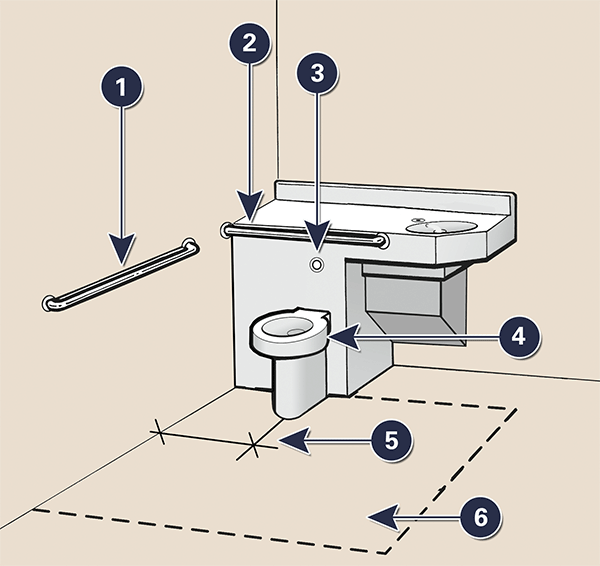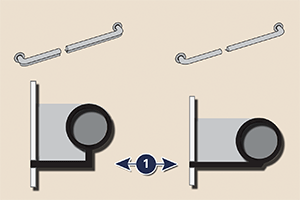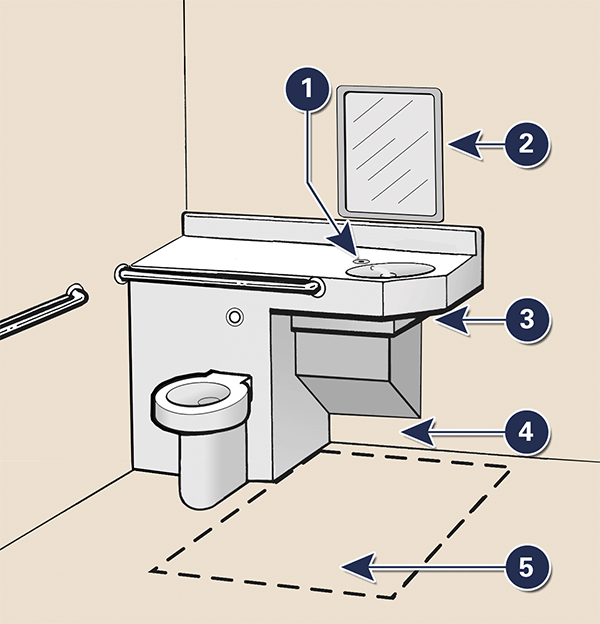| U.S. Department of Justice Civil Rights Division Disability Rights Section |
 |
![]()
Americans with Disabilities Act
Section 504 of the Rehabilitation Act
ADA/Section 504 Design Guide:
Accessible Cells in Correctional Facilities
Many inmates in State and local correctional facilities have mobility disabilities and need to be housed in accessible cells. Yet, many correctional facilities do not have enough cells that are accessible to inmates with disabilities. Federal laws protect people with disabilities from discrimination by State and local governments, including entities that own or operate correctional facilities. All such entities are covered by the Americans with Disabilities Act of 1990 (ADA), and those that receive Federal funds are also covered by section 504 of the Rehabilitation Act (Section 504).1 These laws prohibit discrimination against persons with disabilities, including inmates who use wheelchairs, walkers, or other mobility devices. While all aspects of law enforcement and correctional services are covered by these laws - including facilities, employment, transportation, and other activities, programs, and services - this guide focuses on the prevention of discrimination against inmates with mobility disabilities through the design of accessible cells.
Security
Accessible cells do not compromise the security of prison personnel. In fact, having accessible cells increases security because they allow inmates with mobility disabilities to function independently, minimizing the need for assistance from corrections officers.
Basic Features
Inmates with disabilities - including those who use wheelchairs - need to be able to enter their cells and move around inside them, using the cells’ features without assistance. What makes this possible? Careful planning and design will incorporate elements such as a wider entrance door, adequate clear floor space, appropriate placement and models of fixtures and furniture, and grab bars.
Location or Dispersion of Cells
Dispersing accessible cells throughout a facility ensures that inmates with disabilities are able to be housed with inmates of the same classification levels. Generally, inmates with disabilities who are not ill do not need to be housed in medical areas unless they are receiving medical care or treatment.
Furniture and Cell Features
Accessible cells need to contain the same features as other cells for inmates housed at the same classification level. For instance, where other cells contain writing desks, accessible writing desks are needed in accessible cells.

Clear floor spaces for inmates who use mobility devices
Room Layout and General Features

Drawing Notes:
- Accessible toilet with rear and side grab bars, clear floor space for wheelchair transfer, and an accessible flush valve.
- Accessible lavatory with knee and toe space below, faucet controls usable with a loosely closed fist, clear floor space for front approach, and lowered mirror.
- Doors with 32 inches of clear opening width (when a sliding door is fully opened or a hinged door is open 90 degrees). Clear floor space is required in front of the door.
- Desk with knee and toe space and clear floor space for front approach.
- Bed with clear floor space for a side approach next to bed.
Appropriate clear floor space (shown by dashed lines) is needed adjacent to each cell feature (see page 1 diagrams on clear floor space). As shown in this drawing, the clear floor spaces for each element may overlap. Inmates with a mobility disability should be able to use, and move without obstruction among, the easily accessible features of their cells. There needs to be adequate turning space within the cell -- either a 60-inch-diameter circle or a T-shaped turn area. (See diagrams on turning space.)
Note:
Some features shown in this document may be inappropriate for cells where inmate suicide is a concern. See the notes for features specifically designed to minimize suicide risk, while providing accessibility for inmates with mobility disabilities.
Features of an Accessible Toilet
![]()

Drawing Notes:
- Side grab bar: There is a grab bar on the adjacent side wall that is at least 42 inches long and from 33 to 36 inches above the floor.
- Rear grab bar: There is a grab bar behind the toilet that is at least 36 inches long and from 33 to 36 inches above the floor.
- Flush valve is located in reach range and is operable without tight grasping, twisting, or pinching.
- Toilet seat height: The toilet seat needs to be from 17 to 19 inches above the floor to permit transfers to and from wheelchairs.
- Toilet centerline: The toilet bowl needs to be centered 16 to 18 inches from the side wall,2 so that inmates with disabilities can use the side grab bar.
- Clear floor space: Adequate space is provided to approach the toilet from a variety of wheelchair transfer positions (i.e. diagonal or side approaches). Generally, the toilet needs to be placed within a 60-inch-wide by 59-inch-deep clear area of the floor.
Note:
Grab bars can be designed so they do not increase suicide risk. As shown, there are several ways for grab bars to be designed with adequate gripping surfaces, while ensuring that nothing can be tied onto them.

- Profiles of accessible grab bars with suicide prevention feature.
Note:
In every instance, regardless of toilet and lavatory configuration, adequate space needs to be provided for inmates who use wheelchairs to transfer onto and off of the toilet.
Features of Accessible Lavatories and Mirrors
![]()

Drawing Notes:
- Faucets: Faucet handles or controls need to be usable with one loosely closed fist, because some people with disabilities can use only one hand and cannot grasp or twist faucets. Lever-operated, push-type mechanisms, and U-shaped handles are acceptable designs.
- Mirrors: If provided, mirrors need to be mounted with the bottom edge of the reflecting surface no higher than 40 inches above the floor.
- Lavatory knee clearance: To allow persons who use wheelchairs to pull under the lavatory and to use the faucet hardware, the following features need to be provided -- a 27-inch-high clearance under the front edge of the lavatory,3 the top of the bowl mounted no higher than 34 inches above the floor, a 27-inch-high clearance for knee space extending at least 8 inches from the front of the lavatory, and a 9-inch-high toe space extending not more than 6 inches from the back wall.
- Burn protection: To protect against leg burns, hot water and drain pipes need to be covered or otherwise configured to protect against contact. Some people with disabilities have little or no sensation in their legs and can be burned without knowing it.
- Clear floor space is needed for a forward approach to the lavatory.
Features of Accessible Furniture
![]()

Drawing Notes:
- Desk size: If provided, the writing surface of desks and writing tables is no higher than 34 inches. To provide adequate knee and leg clearance, desks and writing tables need to have at least 30 inches of knee width, 29 inches of knee height, and 19 inches of leg depth.
- Beds: Providing beds at an appropriate height, generally from 17 to 19 inches, facilitates transfers to and from wheelchairs. In some cases, an appropriately mounted grab bar can assist an inmate to transfer between the bed and a wheelchair.
- Desk clear floor space: If provided, desks and writing tables need to have a 30-inch by 48-inch clear floor space that extends 19 inches under the desk and any fixed seat needs to be removable.
- Bed transfer space: A 30-inch by 48-inch clear floor space facilitates transfer from a wheelchair to the bed.
All furniture placed in accessible cells for the use of inmates with disabilities needs to be accessible.

60-inch (1525mm) Diameter Space and T-Shaped Space for 180 Degree Turns
![]()
For more information about the
Americans with Disabilities Act (ADA), please visit the Department of Justice’s Home Page, archive.ada.gov, or call us on the ADA Information Line.
800-514-0301 (voice)
833-610-1264 (TTY)
Reproduction is encouraged.
1 While the accessibility standard for new construction and alterations under the ADA is the 2010 ADA Standards for Accessible Design (the 2010 ADA Standards), the accessibility standard for new construction and alterations under section 504 is the Uniform Accessibility Standards (UFAS). While most of the requirements are the same under both sets of standards, we have noted some differences between the two, where applicable.
2 Under UFAS, the toilet bowl centerline must be 18 inches from the side wall.
3 UFAS provides for a 29-inch high clearance.
The Americans with Disabilities Act authorizes the Department of Justice (the Department) to provide technical assistance to individuals and entities that have rights or responsibilities under the Act. This document provides informal guidance to assist you in understanding the ADA and the Department's regulations.
This guidance document is not intended to be a final agency action, has no legally binding effect, and may be rescinded or modified in the Department's complete discretion, in accordance with applicable laws. The Department's guidance documents, including this guidance, do not establish legally enforceable responsibilities beyond what is required by the terms of the applicable statutes, regulations, or binding judicial precedent.
February 25, 2020